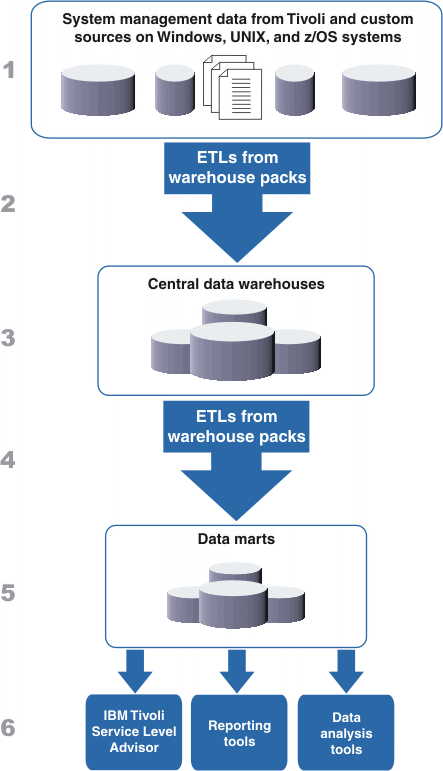Context
Tool mentors explain how a tool can perform tasks, which are part of ITUP processes and activities. The tasks are listed as Related Elements in the Relationships section.
You can see the details of how processes and activities are supported by this tool mentor, by clicking the links next to the icons:
Details
IBM® Tivoli® Data Warehouse facilitates effective availability management by aggregating and reporting on your
availability data. Tivoli Data Warehouse is a central repository for all historical systems management data. Vital data
is collected and aggregated into Tivoli Data Warehouse from various incident tracking and monitoring tools. Incident
data such as the number and classification of incidents, occurrence time, and incident resolution information are
centrally located and reported for analysis. By viewing aggregated incident information through Tivoli Data Warehouse,
trends are identified and root causes can be determined. This valuable information will prevent incidents from
recurring, and from resulting in significant service unavailability.
IT personnel are able to analyze their effectiveness of the fundamental business requirement for high levels of
availability. Longer term availability data is used to ensure that previously agreed upon availability targets are
attainable. When a revaluation of availability thresholds is needed, data to support the change is easily accessible to
all interested parties through the Web-based reporting tool in Tivoli Data Warehouse.
The figure below illustrates how Tivoli Data Warehouse fits into your IT enterprise. The numbers in the figure
correspond to the numbers in the textual description below:

Figure 1: Fitting TDW into an enterprise
-
Your environment contains many products and services that monitor and manage your IT enterprise. This software can
run on a z/OS system or on distributed systems such as Windows, AIX, and other UNIX®-based operating systems. These
products and services generate data that is stored in a variety of formats, including relational databases,
spreadsheet data, log files, and other formats. This data is called operational data, and the databases and files
in which it is stored are referred to as operational data stores. In the Availability Management Process, these
operational data stores contain monitoring data from tools such as ITM.
-
Extract, transform, and load (ETL) programs take the data from these various sources and place it in a central data
warehouse. This action often requires that the data be aggregated and converted into the standard format for
historical data in the central data warehouse. These central data warehouse ETL programs are provided in
applications called warehouse enablement packs, hereinafter called warehouse packs, which come from various
sources:
-
The product that generates the operational data. For example, IBM Tivoli Enterprise Console® provides a
warehouse pack that contains the ETL program to populate the central data warehouse.
-
A product that analyzes data that is captured by other products. For example, an independent software
vendor might write a warehouse pack to extract operational data that is collected by a system management
product that does not provide a warehouse pack.
-
A customer-created warehouse pack. For example, if there are no products that analyze the data that is
important to your enterprise, you can write your own customized ETL program to capture the specific
historical data that you want to analyze.
-
The central data warehouse contains the historical data from all your diverse sources. This data store is optimized
for the efficient storage of large amounts of data and has a documented format, which makes the data accessible to
many analysis solutions.
-
Another set of ETL programs extracts a subset of historical data from the central data warehouse. This subset of
data, called a data mart, contains data that is tailored to and optimized for a specific reporting or analysis
task. Like the ETL programs in step 2, these data mart ETL programs are typically packaged in warehouse packs,
which come from a variety of sources. A data mart ETL program can access any data in the central data warehouse,
including data placed there by the central data warehouse ETL program of another warehouse pack.
-
The data marts, which are subsets of the historical data that satisfy the needs of a specific department, team, or
customer, are optimized for interactive reporting and data analysis.
-
You use a program to analyze a specific aspect of your enterprise, such as availability management, using the data
in one or more data marts. Tivoli Data Warehouse provides Crystal Enterprise, a Web-based tool, for reporting. It
is also possible to use other programs to access TDW data marts and perform OLAP analysis or data mining.
For More Information
For more information about this tool, click on the link for this tool at the top of this page.
|

